“Sometimes dreams are wiser than waking.” -Black Elk: Holy Man of the Oglala Sioux
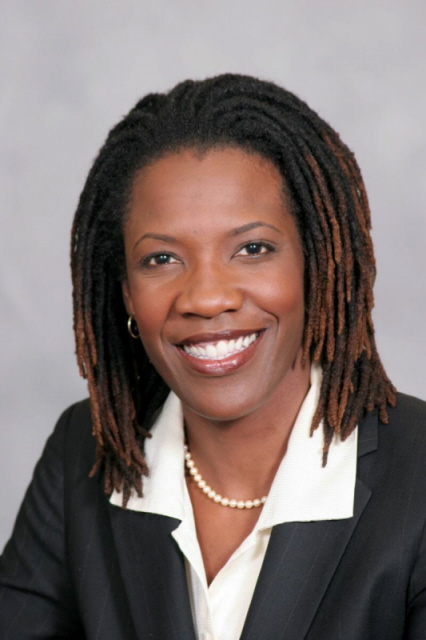
A couple weeks ago I had the pleasure of meeting Kim Batten in person, then a few days ago I spoke with her on the phone about that glorious race, her illustrious track career, her current work as the owner of a sports performance company, and her passion for youth athletics.
In the Beginning
A native of Rochester, NY, Batten did not choose track and field as her first sport. She played basketball. “I was actually pretty good in basketball,” she said. “I was a shooting guard, but I could also play the point.” She didn’t go out for track until her junior year at East High School. She did so in order to keep a promise to the track coach, Betty Rich, who was also her basketball coach. In track, the 5-7 Batten started off as a triple jumper (an event she still loves and would love to coach) and long jumper, and then took on the 400 hurdles. Keep in mind that New York is one of the few states in which high schoolers compete in the 400 hurdles, not the 300’s. About that, Batten said, “running the 400 hurdles was a tremendous advantage – not needing to make any transition once I went to college.”
But, heading into college, the triple jump remained her focus. She was recruited as a triple jumper, having finished her senior year ranked #3 in the nation. Meanwhile, her high school personal best in the hurdles was a very strong but not-so-stunning 60.94.
From Rochester’s East High, Batten moved on to Florida State University in Tallahassee. Lisa Horton, a high school teammate, had gone there the year before. So the coaches at FSU knew Coach Rich and knew to look to her for more athletes. Although Batten received many letters from other schools, the only other school to show significant interest was the University of Minnesota. As a big fan of the musical phenom Prince, a native Minnesotan, Batten went there to visit. “It was the only visit I had,” she said.
From College to the Pros
At FSU, Batten competed in the triple jump, long jump, 100, 200, 400 hurdles, 100 hurdles, and often ran relay legs. She was a good collegiate athlete who scored plenty of points for her team but had no aspirations of embarking on a professional career. “The system was different,” she explained. “It was still TAC (The Athletics Congress – the national governing body prior to the inception of USATF). I had no understanding of professionalism and the European circuit until my junior year (1990). That’s when I started taking the 400 hurdles seriously, when I did pretty well at the national meet. My coach (Terry Long) was like, you can continue to do this if you’d really like to.
At USA Nationals that year, Batten made the final and finished seventh in the 400 hurdles, after not making it out of the first round of the Olympic trials two years earlier. She also lowered her personal best down to 55.45, down from 58.60 her sophomore year. Track & Field News ranked her 7th in the event in the United States. And with her upcoming senior year also being a World Championship year (the World Championships were held only once every four years back then), 1991 would be a make-or-break year career-wise. If she were to turn pro, she’d have to have a huge season. Otherwise, she might have to rely on her impending degree in social work to land herself a job in that field.
The collegiate part of the year went exceptionally well, as she set personal bests in the 100 hurdles (13.06), long jump (20-4.5), and triple jump (42-6). In the 400 hurdles, she finished 3rd at NCAA Nationals with a 56.28, putting herself in a good position to make the World Championship team heading into USA Nationals. There, she would have to face, among others, the great and flamboyant Sandra Farmer-Patrick. Farmer-Patrick’s long, flowing hair and bright, elaborate outfits starkly contrasted the simple, unassuming look of Batten, who wore her hair short and dressed conservatively. Farmer-Patrick had already established herself as one of the best 400 hurdlers in the world, having won in, 1989, the National Championships, the World Cup, and the Grand Prix Final. After battling injuries in 1990, she was back, ready to reclaim her mantle of supremacy.
But Batten proved to be up to the challenge, earning her first national championship in a new personal best of 54.18. She had beaten the woman in the bright dress. “At that point,” she says, “I knew I was on my way to being pretty good.” About Farmer-Patrick she says, “I appreciate individuality in our sport. I love people who are flamboyant and can rock it well, even though that’s not me.”
Batten went on to finish fifth at the World Championships, even though she lowered her personal best, dipping under 54.00 for the first time with a time of 53.98 in the final. At season’s end, T&FN ranked her 4th in the world, 3rd in the US. She was only twenty-two years old, but it was already safe to say that Kim Batten had arrived on the international scene.
So began Batten’s life as a professional track athlete. Though she had graduated, she stayed in Tallahassee and trained under Coach Long. “I was lucky and blessed enough,” she says, “to have a great coach who looked out for me in so many ways and provided a platform in which I could be the best I could be.”
As a pro, Batten found that her track life didn’t change much. The only difference was “I worked harder,” and she could focus exclusively on her specialty event. In 1992 she finished fourth at the Olympic trials. In 1993 she finished second at the National Championships and fourth at the World Championships in a new personal best of 53.84. In that race, both Farmer-Patrick and Britain’s Sally Gunnell smashed the old world record, with Gunnell claiming the gold in 52.74, and Farmer-Patrick, who led much of the way, sprinting in right behind her in 52.79. Did Batten know that, two years later, she too would be part of a duo that would break the previous world record? No she didn’t. But the dream of running such a race, of putting it all together, kept the competitive fires within her burning.
She ended 1993 ranked 3rd in the world (behind Gunnell and Farmer-Patrick) and second in the US. In 1994, a dead year, with no World Championships and no Olympics, Batten won the US Championships and was ranked second in the world, first in the US.
Then came 1995.
The Race
She started off the year by running “my fastest opener ever – 53-something. I was like, this year I’m going for it. At the time I was skeptical about the possibilities of a woman running under 52. That’s because I knew how much it hurt to run 54. But after that race in Brazil, I was like, I can run 52. I’m convinced I was on my way to running that fast – 51.9.” But on the plane back home to Rochester, she felt “tremendous pain” in her side. She told her mom, a nurse, that she felt very sick. After spending a night at her childhood home, she went to the emergency ward of the local hospital the next morning. The doctor informed her that her appendix was inflamed, and that he would need to do exploratory surgery to correct the problem.
Batten recalls, “I said whatever you do, explore very gently. I have a season to run.” The doctor assured her that he could perform the surgery with the least amount of invasion as possible. “They found out,” Batten says, “that my appendix was on its way to erupting. They caught it in time. But this was in May. I remember thinking my season was over. I was in great shape, so I had plenty room for error. But I didn’t have much time before nationals. I remember walking around my high school track a couple days after the operation and it took me twenty minutes to get around that thing.”
Against her doctor’s orders, she returned to Tallahassee to train. “I got back in the weight room. Started doing squats. It was crazy. I could hear the stitches pop with every rep. In my running workouts, with every effort I made, I could feel the scar tissue and the soreness in the spots where the doctors went in. I was testing the limits of what I could do. I was like, you know what, I can be ready by nationals. I honestly wasn’t expecting to win; I just wanted to make the team. I knew the other women would be ready and they each had their own mission. But I knew that after Sandra and Tonja (Buford), I could get that third spot.”
To her own surprise, not only did she make the team, but she won US Nationals, although in a relatively slow time of 54.74. “In the final” she says, “I was like, I got a chance. I didn’t run very fast, but I won.” With that victory, she bought herself more time to heal and train for the World Championships.
“By worlds,” she says, “I was good. I had no pains.” With Gunnell out with injury, Batten “felt like I was in a position where I could actually win something here.”
She got through the rounds with no problems. It was looking like she and Buford, along with Jamaica’s Deon Hemmings, were shaping up to be the top contenders for the gold. Batten recalls the tension between herself and Buford in the build-up to the final:
“Tonja and I were good friends; we roomed together, ate together. This was the first time we’d look at each other and neither of us had anything to say. We knew we both had the opportunity to change our lives … forever. It was difficult for us to be around each other. I would be sweating when I was around her. There was so much pressure. We kind of avoided each other a little bit. Coach Long wasn’t there with me, and this was one of the first times he hadn’t been able to come. I had told him don’t worry about it. I could just talk to him on the phone. I talked to him the night before the final and I told him, ‘You know what Terry, I had a dream that I broke the world record.’”
That dream would prove to be prophetic.
In describing the race itself, Batten says the following: “I knew that my rhythm was amazing. Even in the semis I just knew… I ran like 54.1 and it was so easy. In the final, I was right on top of hurdles, so I could take advantage of my stride length. I was hitting my marks for when I wanted to alternate.”
The rhythm she had sunken into, the zone she had entered, she had not entered into alone. In a way that perhaps can be described as mystical, she and Buford had entered the zone together. As they cleared the seventh hurdle and powered down the homestretch, they were so unified that the idea of competing against each other momentarily faded.
“If Tonja had not been in the race,” Batten says, “and if she hadn’t been in the lane right next to me, I don’t know if I would’ve broken the record, or that she would have. We had a rhythm together. Neither of us pressed to get ahead of the other; it was like two people dancing. It wasn’t until the last hurdle that I realized I would have to surge somewhere.”
In Tallahassee, when warming up with a one-lap jog with her training partners, they would often jokingly lean at the finish line to beat each other. You never know, one of her training partners would tell her, when you that lean will be the difference. On that glorious day in Goteborg, Sweden, the lean was the difference. Batten won in a new world record of 52.61. Buford finished one-hundredth of a second behind her.
“In the end,” Batten says, “I didn’t know how fast we ran, and I didn’t know who won. I went up to her, she was leaning down. I said to her, ‘Oh my God! We broke the world record!’ If you look at the tape, you can see me saying, ‘Oh my God, Oh my God.’ I have never been so happy for someone as I was for her….”
In reliving the events of that day, the emotions of that moment, Batten had to pause and gather herself before continuing, in a very somber tone: “I wish Tonja would’ve broke the world record. I wish it would’ve been a tie. All these years she’s had to deal with not being the best. She’s my friend. I care about her enough as an athlete and as a person that I want for her what I’ve been able to have – to relish in the glory of what she did. It was as tremendous as what I did. One hundredth of a second. You can’t give me credit without giving her credit. I’m blessed that we have been able to continue a wonderful friendship since that day. Even with your competitors, you can’t separate yourselves from what you’re trying to do. You can’t dislike each other for trying to accomplish the same thing.”
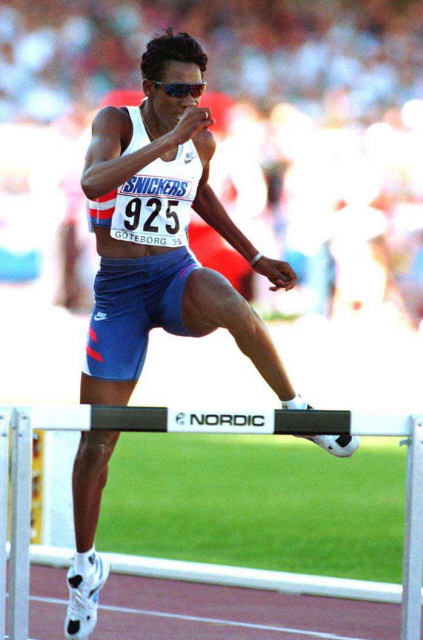
Batten aggressively attacks a hurdle on her way to World Championship gold and a new world record.
Atlanta Olympics
She finished the 1995 season with her first-ever #1 world ranking. In 1996, with the Olympic Games being held on US soil in Atlanta, GA, Batten looked to continue her reign as queen of the hurdles. The stiffest competition would again come from Buford (now Buford-Bailey) and WC bronze medalist Hemmings. She had enormous respect for both of them. “They could beat me,” she explained. “On any day. We lined up against each other all the time. We didn’t dodge races because we didn’t want to get beat. We had the courage to say, this girl can beat me, but let me go out here and do my best. Sometimes I won, sometimes Deon, sometimes Tonja.”
Batten once again won the US Championships, this time in 53.81, punching herself a ticket to the Games. In Atlanta, she breezed through the rounds and was leading for much of the way in the final, but made a tactical mistake:
“I had a set pattern that I could maximize if I could execute it. I’d take 15 strides through the first six, then 16 to seven and eight, and 17 the rest of the way. At the Olympics I got into the semis and ran 15 the whole way. That totally scared me beyond belief. I had never been able to 15-step all the way around the track before. I realized that wow, this track is real fast, and I could probably break the record again if I run that stride pattern again. Ultimately, I always wanted to run a 15-stride pattern the whole way, like Edwin [Moses] did 13 the whole way. That way, no one would ever beat me. At the Olympic Games, I got thrown for a loop because that was the first time I had 15’d the whole way. In the final, at hurdle 8, I had to stutter a little bit. I couldn’t carry the new stride pattern like I had hoped to, and I got caught, and it cost me the race. I should’ve alternated at hurdle 7 and been more conservative. But I had big hopes. My family was there. I got caught up in the idea of trying something new. It was the costliest mistake I made my whole career.”
Hemmings took advantage of Batten’s error and passed her on her way to the gold medal in a time of 52.82. Batten settled for the silver in 53.08, and Buford-Bailey claimed the bronze in 53.22.
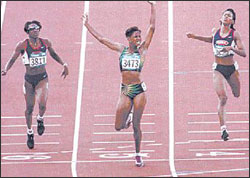
Batten, Hemmings, Buford-Bailey
“I was happy with my silver,” Batten says, “because I realized immediately what I had done wrong. I didn’t run a good race; I ran a pressed race. I wasn’t necessarily chasing the world record. And I felt like I could’ve won with my normal stride pattern, so it wasn’t like I felt like I had to 15-step the whole way in order to win. But I saw the opportunity to do something I had always wanted to do – run that 15-stride pattern.”
Despite her mistake, Batten gives Hemmings credit for running a great race. “Deon took us to town on our home turf. She deserved to win.”
So Batten’s 1996 was a disappointment only when evaluated according to the high standards she had set for herself the previous year. She still ended up ranked 2nd in the world and 1st in the nation, and the future looked bright.
Throughout the rest of the 1990’s, Batten remained at or near the top among female 400 hurdlers. In 1997 she won the US Championships in another sub-53.00 race – 52.97, then went on to earn a bronze medal at the World Championships in 53.45, finishing behind gold medalist Nezha Bidouane of Morocco and silver medalist Hemmings. In 1998 she grabbed her sixth consecutive national championship, this one in 53.61. Though she finished only third at the Goodwill Games – the biggest meet of the year in terms of the number of countries participating – she ran two blistering races on the European Grand Prix tour – a 52.84 in Zurich and a 52.74 in Monaco.
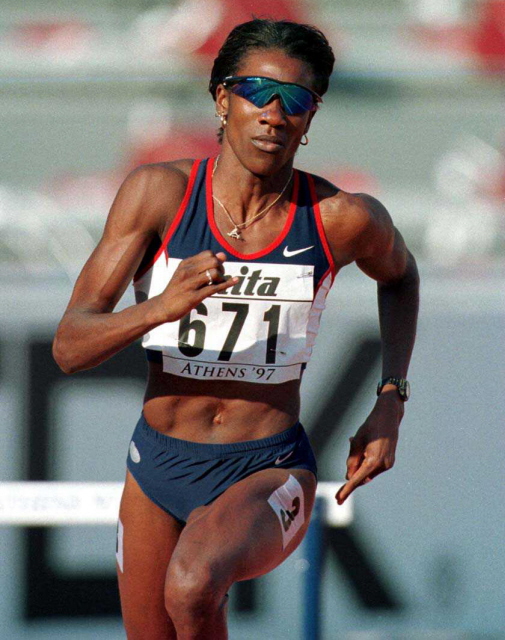
At the 1997 World Championships in Athens, Greece
Injuries
By this point in her career, Batten had run under 53.00 four times, and had clearly established herself as being arguably the greatest 400 hurdler of all time. But then, in 1999, her body began to betray her. She had struggled with foot problems throughout her career, but now they started to catch up with her. She DNF’ed at the national championships, ending her streak, and could only muster a season best of 53.99.
“There wasn’t a season I wasn’t hurt,” she says, pointing out that the foot problems didn’t just suddenly appear in ‘99. “With anything you do repetitively, there’s some part of your body that’s going to be affected. For me it was [a bone chip in] the foot of that lead leg coming down on that toe. There were times I would get cortisone shots to alleviate the pain. Prior to nationals in ’99, I flew home [to Rochester] from Athens [Georgia], and it flared up real bad. That’s the year I fell [at nationals] because it was so painful that I didn’t hardly lift my leg. That was pretty much the season. It started happening in ‘98, trying to go for the world record again. It was so hard.”
It was in ’98 that thoughts of retirement first entered her mind. “I remember sitting on the bus [on the way home from a meet] and thinking, this might be my last season.” But she continued to march on. In 2000 she laced up her spikes for another Olympic bid. “I got a new spark going into that year,” she says. “But I was so out of shape because I couldn’t train with all that pain in my foot. I ran a total of two races in 2000 – the trials and the Olympics.”
She made her second Olympic team, finishing second at the National Championships in 54.70. But at the Games in Sydney, Australia, she didn’t get far, bowing out in the semi-final round with a 55.73, good for sixth place in her heat.
“I wish I would’ve gone ahead and retired in 98,” she reflects. “I didn’t need to do it anymore. My heart wasn’t in it.” She ran a few races in 2001 and managed a #5 ranking in the nation, but the writing was on the wall. Her foot would not let her train the way she needed to train. In 2002, she retired from competition and moved to Atlanta. The following year, her world record was broken by Russian Yuliya Pechonkina, who ran a 52.34, prompting Batten to make an ill-fated comeback attempt in hopes of reclaiming her record. But it was definitely a no-go. “I realized,” Batten says, “how hard I had worked to get to the level I had gotten to. I couldn’t work like that anymore.”
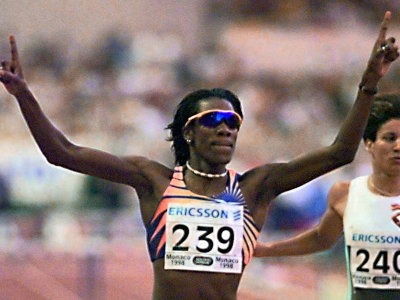
Batten celebrates a victory on the European circuit.
Coaching the Kids
With her sports performance company, Body By Batten, she works with many youths in the Atlanta area. Many of them run for local track clubs. “Really I help with a number of track clubs to work with kids. With the company, I try to assist a number of track clubs.” In these youngsters she sees the future of the sport, and takes her role of shaping their bodies and minds very seriously.
One of the kids Batten has had a tremendous impact upon is hurdler William Wynne, who currently runs for the University of Florida. As a prep, Wynne ran 49.70 over the 400 hurdles – the 3rd-fastest ever for a high school athlete. While much of the credit for his development goes to the members of the Titans Track Club coaching staff led by Tony Carpenter, Batten’s influence helped Wynne to become one of the top high school double hurdlers in history.
Batten explains, “When I came to Atlanta, I was asked to come on board [the Titans Track Club staff] and assist with some of the coaching practices, and with Will Wynne in particular. I worked with them for a year, and with Wynne for a couple more years, until he went off to college. That experience was really a blessing. I learned a lot about myself as a coach. I realized that I really love teaching youth and working with elite athletes. He did very well, not totally on my talents, but from the assistance of a number of coaches – Tony and Wendy [Truvillion]. I worked with Will in relation to his hurdling. It was fun reliving the things my coach taught me. It was challenging yet very stimulating.”
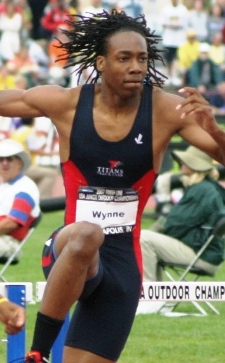
William Wynne
Another athlete in whom Batten sees much potential is Lashinda Demus, who just recently won the US Championship in the 400 hurdles in 53.78. According to Batten, Demus, who ran a personal best of 53.02 in 2006, “is the one” who has the ability to break the world record. “That girl is so freakin’ talented,” Batten says. “She’s way more talented than I was. I really think that girl could run 51.”
If Batten says Demus can do it, then there’s no reason for the rest of us to doubt it.
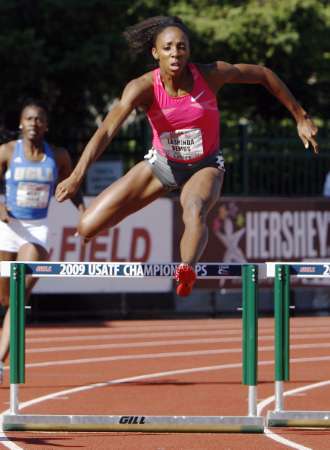
2009 National Champion Lashinda Demus
In Closing
A couple weeks ago I visited the Atlanta area to help with the hurdlers of The Heat Track Club in Marietta, led by Coach Blane Williams. During one of the training sessions, Kim Batten appeared. I saw her walking with Coach Williams as I was working with the kids. Though she wore her hair in long locs, unlike the short, straight strands she wore in her competitive days, I recognized her instantly. Having coached some excellent hurdlers over the years, and having interviewed such giants as Renaldo Nehemiah, Tonie Campbell, Kevin Young, and Edwin Moses, I didn’t think I could be star-struck anymore.
But when I saw Kim Batten standing there, smiling and nodding at something Coach Williams was saying, all I could think of was that race in 1995. Batten and Buford sailing down the homestretch, into the arms of forever. Like something out of a dream….
© 2009 Steve McGill
